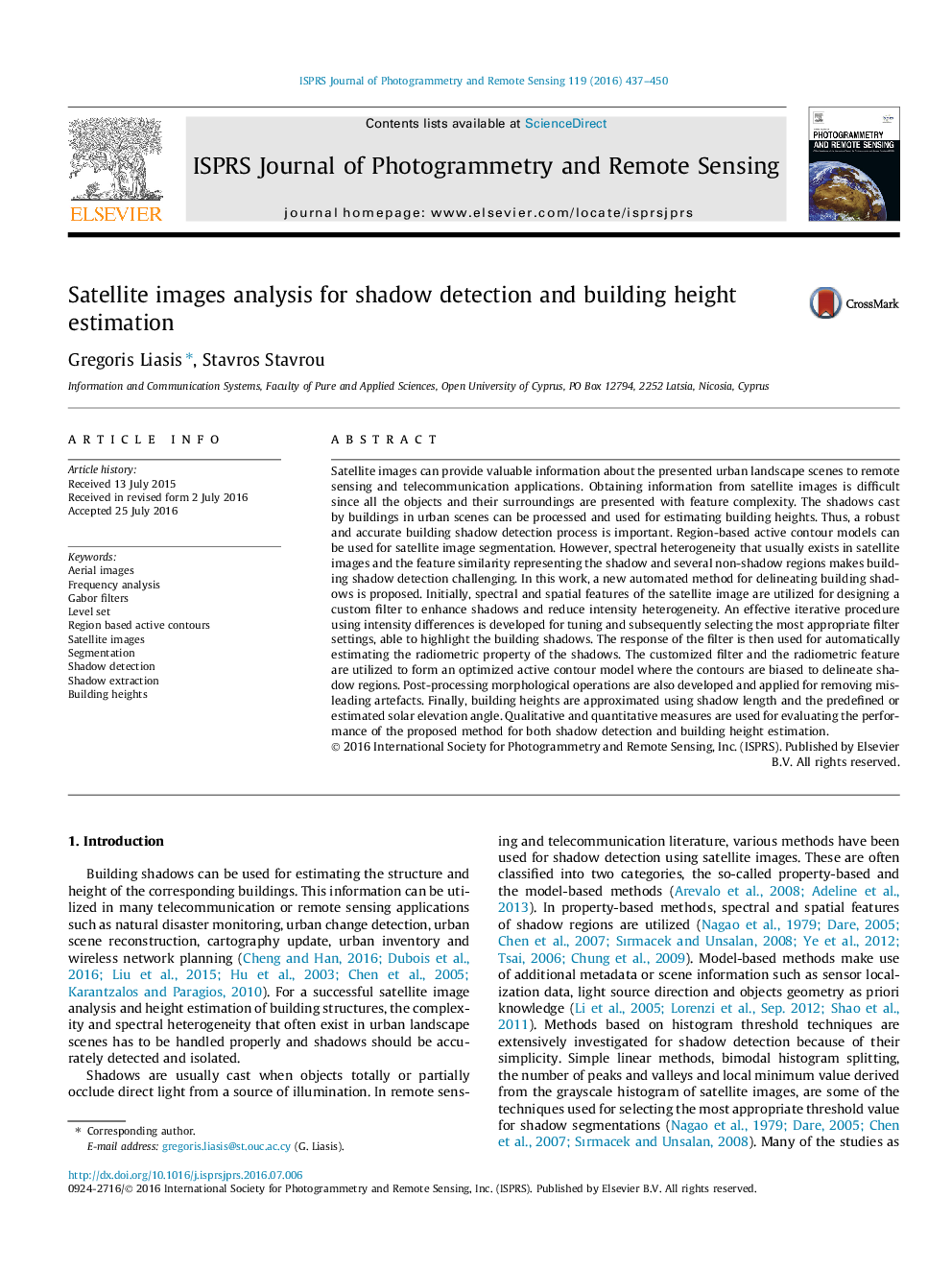| کد مقاله | کد نشریه | سال انتشار | مقاله انگلیسی | نسخه تمام متن |
|---|---|---|---|---|
| 6949316 | 1451255 | 2016 | 14 صفحه PDF | دانلود رایگان |
عنوان انگلیسی مقاله ISI
Satellite images analysis for shadow detection and building height estimation
ترجمه فارسی عنوان
تجزیه و تحلیل تصاویر ماهواره ای برای تشخیص سایه و تخمینی ارتفاع ساختمان
دانلود مقاله + سفارش ترجمه
دانلود مقاله ISI انگلیسی
رایگان برای ایرانیان
کلمات کلیدی
تصاویر هوایی، تجزیه و تحلیل فرکانس، فیلتر گابور، سطح تنظیم، مناطق فعال مبتنی بر خطوط، تصاویر ماهواره ای، تقسیم بندی، تشخیص سایه، استخراج سایه، ارتفاع ساختمان،
ترجمه چکیده
تصاویر ماهواره ای می توانند اطلاعات ارزشمندی در مورد صحنه های چشم انداز شهرستانی ارائه شده به برنامه های سنجش از راه دور و ارتباطات مخابراتی ارائه دهند. دریافت اطلاعات از تصاویر ماهواره ای دشوار است زیرا تمام اشیاء و محیط اطراف آنها با پیچیدگی ویژگی ارائه می شود. سایه هایی که توسط ساختمان ها در صحنه های شهری اجرا می شود می تواند مورد پردازش قرار گیرد و برای تعیین ارتفاع ساختمان استفاده شود. بنابراین، یک پروسه تشخیص سایه ساختمان قوی و دقیق مهم است. مدل های کانتور فعال مبتنی بر منطقه را می توان برای تقسیم بندی تصاویر ماهواره ای استفاده کرد. با این حال، ناهمگونی طیفی که معمولا در تصاویر ماهواره ای وجود دارد و شباهت های ویژگی هایی که سایه ها و چندین سایه را نشان می دهند، باعث ایجاد تشخیص سایه ها می شود. در این کار یک روش خودکار برای تعریف سایه های ساختمان پیشنهاد شده است. در ابتدا، ویژگی های طیفی و فضایی تصویر ماهواره ای برای طراحی یک فیلتر سفارشی برای افزایش سایه ها و کاهش ناهمگونی شدت استفاده می شود. یک روش تکراری موثر با استفاده از تفاوت شدت برای تنظیم و پس از آن انتخاب مناسب ترین تنظیمات فیلتر، قادر به برجسته شدن سایه ساختمان است. سپس پاسخ فیلتر برای به طور خودکار تخمین خواص رادیومتری سایه ها استفاده می شود. فیلتر سفارشی و ویژگی رادیومتری برای ایجاد یک مدل کنتور فعال بهینه سازی شده که در آن کانتورها برای تعریف مناطق سایه تعریف می شوند، مورد استفاده قرار می گیرند. عملیات مورفولوژیکی پس از پردازش نیز برای حذف آثار گمراه کننده مورد استفاده قرار می گیرد. در نهایت، ارتفاع ساختمان ها با استفاده از طول سایه و زاویه ارتفاع از پیش تعیین شده یا تخمین زده می شود. برای ارزیابی عملکرد روش پیشنهادی برای تشخیص سایه و تخمین ارتفاع ساختمان، از روشهای کیفی و کمی استفاده شده است.
موضوعات مرتبط
مهندسی و علوم پایه
مهندسی کامپیوتر
سیستم های اطلاعاتی
چکیده انگلیسی
Satellite images can provide valuable information about the presented urban landscape scenes to remote sensing and telecommunication applications. Obtaining information from satellite images is difficult since all the objects and their surroundings are presented with feature complexity. The shadows cast by buildings in urban scenes can be processed and used for estimating building heights. Thus, a robust and accurate building shadow detection process is important. Region-based active contour models can be used for satellite image segmentation. However, spectral heterogeneity that usually exists in satellite images and the feature similarity representing the shadow and several non-shadow regions makes building shadow detection challenging. In this work, a new automated method for delineating building shadows is proposed. Initially, spectral and spatial features of the satellite image are utilized for designing a custom filter to enhance shadows and reduce intensity heterogeneity. An effective iterative procedure using intensity differences is developed for tuning and subsequently selecting the most appropriate filter settings, able to highlight the building shadows. The response of the filter is then used for automatically estimating the radiometric property of the shadows. The customized filter and the radiometric feature are utilized to form an optimized active contour model where the contours are biased to delineate shadow regions. Post-processing morphological operations are also developed and applied for removing misleading artefacts. Finally, building heights are approximated using shadow length and the predefined or estimated solar elevation angle. Qualitative and quantitative measures are used for evaluating the performance of the proposed method for both shadow detection and building height estimation.
ناشر
Database: Elsevier - ScienceDirect (ساینس دایرکت)
Journal: ISPRS Journal of Photogrammetry and Remote Sensing - Volume 119, September 2016, Pages 437-450
Journal: ISPRS Journal of Photogrammetry and Remote Sensing - Volume 119, September 2016, Pages 437-450
نویسندگان
Gregoris Liasis, Stavros Stavrou,
